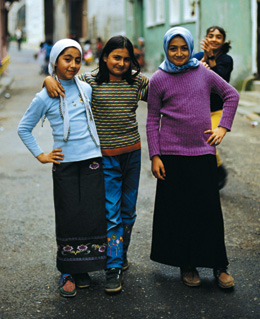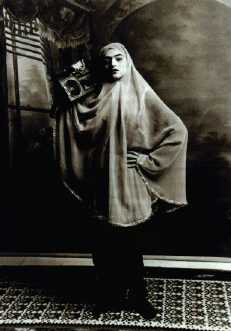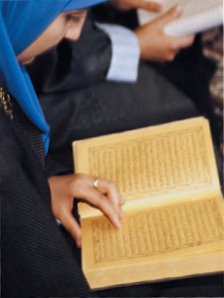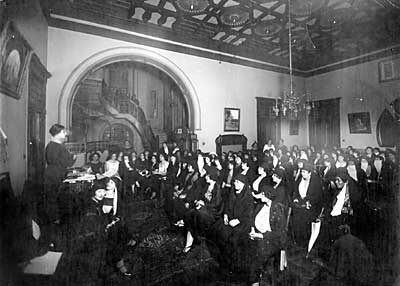|
|
Toronto Website Design & Toronto SEO
Islam and Feminism:
Are the barriers coming down?

Islamic Feminism I - Islamic Feminism II - Islamic Feminism III - Islamic Feminism IV

By Caryle Murphy.
If there is common ground to be found between Western feminists and women in the Muslim world, it is being discovered slowly—but thoughtfully—by women from both secular and religious backgrounds.
In 1979, feminist author Kate Millett went to Iran in the midst of its tumultuous Islamic revolution. She demonstrated with Iranian women in the streets of Tehran. She declared that “religion and clothing are something private” and insisted that “nobody can force” women to wear Islamic-style dress. Millett also trumpeted her vision of global sisterhood at a chaotic press conference. “We are an international movement, the women’s movement,” she said. “I had understood there to be a few struggling feminists in Tehran...[N]ow there are thousands and thousands in the street...who hope to build a movement here...What is happening in Iran may herald the rise of women throughout Islam and the Near and Middle East.”
As Millett related in her 1982 book, Going to Iran (Coward McCann, 1982), her message was not well received. She and her Iranian friends were heckled for presuming to speak for Iranian women. One woman challenged Millett’s presence in her country, saying, “As women in Iran we are very happy to have you here. It’s very nice of you to want to help us in this situation. But help us in our way, not in an American way.”
One day twenty years later, the telephone rang in the offices of the Los Angeles-based Muslim Women’s League, an organization of American Muslim women. A staff person from the Feminist Majority Foundation was on the line with a request. The Foundation was staging a rally to deplore the Taliban’s repression of Afghan women, she said, and wanted to borrow some burqas for the event. “They assumed we all had burqas!” says Laila Al-Marayati, a U.S.-born founder of the League. “To make the assumption that we all have that, that we all dress the same, I was so offended. It was a total lack of cultural sensitivity.” The League was doubly insulted because it had twice written the Foundation suggesting some joint projects but never received a response. “They weren’t interested in our participation at all,” adds Al-Marayati. “Even though we’d be natural bridges to women in other countries.”
Much has changed in the worlds of both Islam and feminism since Millett’s trip to Iran. But American feminists and Muslim women seem as estranged as ever. On an institutional level, their relations remain plagued by stereotypes and mutual suspicion. Their dominant worldviews—one secular, the other faith-based—seem irreconcilable. “When the Taliban were overthrown, the attitude was ‘Now you’ve been liberated by us, we expect you to take off the veil and become like us. Throw off Islam,’” says Pakistan-born Riffat Hassan, a professor of religious studies at the University of Louisville in Kentucky and a women’s rights activist. “There is an imperialist vein in American feminism. I see that clearly at times.”
Muslims complain that many American feminists remain ignorant about Islam and unaware of groundbreaking theological work on women’s rights being done by female Muslim scholars. They also criticize feminists for dismissing faith-based women’s movements, “matronizing” Muslim women, and being fixated on the Islamic head cover.
At the same time, Muslim women are often overly sensitive and defensive when feminists make mistakes. (A Feminist Majority Foundation spokeswoman says that when they called the Muslim Women’s League looking for a burqa, “we didn’t assume they wore burqas or anything like that.”) Some also reject feminism as inimical to Islam without bothering to ask the person using the word what she means by it. Others demonize anything Western, and resort to formulaic apologias for Islam rather than acknowledge the problems that women face in Islamic societies. “Some Muslim men and women are extremely defensive when they perceive criticism and they don’t spend the energy to check where that belief is coming from and talk about it,” says Uzma Mazhar, a Muslim psychotherapist in St. Louis. “They don’t go beyond their initial reaction to have a dialogue.”
Astonishingly, women interviewed for this article could not recall a single gathering designed solely to promote dialogue between American feminists and Muslim women. Instead, dialogue has come only as an unintentional byproduct of meetings convened for other purposes. “We come together to talk about issues but we never get to talk about stereotyping each other,” says Azizah al-Hibri, president of KARAMAH, a Washington, D.C. organization of female Muslim lawyers.
Despite this formal estrangement, however, a more nuanced portrait emerges on other levels of interaction. In the academic arena, and in grass-roots encounters that have proliferated since the September 11th terrorist attacks, women on both sides are beginning to view each other with greater understanding and trying to build working relationships, according to recent interviews and a survey of the newest literature. “As someone who works in that field,” says Mohja Kahf, “I do think the situation is actually improving among Western feminists.” A poet and professor of comparative literature at the University of Arkansas, Kahf, who came to this country from Syria when she was three, says she has seen “more sophistication” in academic writings about Islam and Muslim women.
Manal Omar also has noticed changes. “Muslim women are learning to take the good and leave the bad from the West and from feminism. There is more of a critical process,” says Omar, a former World Bank employee of Palestinian descent with extensive experience in international development projects. “And on the side of Western feminists, they are becoming more sensitive in their approach to understanding other cultures and religions. It’s an overall tone I’ve been seeing.”
Increased contacts in the American workplace—where Muslim women have become increasingly visible—and in international development projects have contributed to the change. Global gatherings such as the 1995 Fourth World Conference on Women, in Beijing, also brought interactions between the two sides. In addition, the mass rape of Muslim women by Christian Serbs in Bosnia, the Taliban’s mistreatment of Afghan women, and the trauma of September 11th all challenged Western feminists to reach out to Muslim women. “There is an understanding that the world has changed,” says Gisela Webb, associate professor of Islamic and women’s studies at New Jersey’s Seton Hall University, “and that the first wave of feminism had the possibility of becoming patriarchal itself.”
Signs of growing mutual understanding are not huge but nevertheless noteworthy. In April, Women’s eNews added an Arabic-language page to its web site to cover women’s issues in
the Middle East and among Arabic-speaking women in the United States. The move was sparked in part because Women’s eNews (www.womensenews.com) had noticed that its English-language site was receiving a significant volume of visitors from Saudi Arabia and Qatar, editor-in-chief Rita Henley Jensen says. The new page, she adds, is also meant to “communicate to the Arab-speaking world that some of us are struggling to find out more about Islam and about Arab-speaking nations.”
Another example of collaboration is the recent book, Nothing Sacred: Women Respond to Religious Fundamentalism and Terror (Thunder’s Mouth Press/ Nation Books, 2002). The volume contains essays by secular American feminists such as columnist Katha Pollitt and dramatist Eve Ensler, as well as scholarly specialists in Islam, notably Karen Armstrong and Leila Ahmed. The book’s theme is that extremists in several religions—not only Islam—threaten women’s rights around the world. In addition, the first conference of an organization called Women for Afghan Women held in late 2001 in New York included both Muslim women’s rights activists and American feminists. “That’s what was so remarkable about it, the inclusivity,” says participant Irena Lieberman, a Virginia attorney who has assisted Muslim women fleeing gender-based persecution. And last May, Muslim women were among female theologians of various faiths who met for a conference on women, religion and social change at Harvard University.
These are small steps on a still-long journey towards deeper rapprochement, which depends on many things, including greater clarity about definitions.
Feminism is the principle that women have an equal right to the same opportunities as men in all spheres of life. But feminism’s content depends on the circumstances of individual women. The word means one thing to a female executive in New York frustrated that the “old boys network” hinders her ascent through the corporate ranks. It means something else to a rural Pakistani widow resisting pressure from male relatives to withdraw her teenage daughters from school so they can be married off.
One reason why Millett’s vision of an international women’s movement foundered was its underlying assumption that all women everywhere wanted exactly the same rights and opportunities that Millett enjoyed as an American. The reality is that there are different expressions of feminism because women in different countries have different priorities. And for some Muslim women, the American feminist movement has become too narrowly identified with issues that are not their top priorities, such as abortion and lesbian rights. “Women’s rights are universal but they have to be fought for in a specific context,” says Nayereh Tohidi, an Iranian-born associate professor of women’s studies at California State University, Northridge. “I don’t believe in global feminism. It’s a fantasy, a romantic idea...The feminist movement is not one movement, but many.”
Another reality is that many Muslims in foreign lands believe that the United States is hostile to Islam and is using women’s rights as the tip of its spear in a cultural “invasion” of the Muslim world. In this atmosphere, the word feminism has taken on nefarious connotations, viewed as a Western movement of men-haters who extol the individual over the community, are sexually libertine and contemptuous of marriage and the family.
As a result, many Muslim women working for gender equality both in the United States and abroad refuse to call themselves feminists. “We don’t use that [word] too much, but we are coming from a female perspective,” says Irfana Anwer, executive director of KARAMAH’s Washington office. “We don’t try to put it into people’s faces...and put people off unnecessarily.”
It is another sign of shifting attitudes, however, that some young American Muslims are no longer averse to the label. Mohja Kahf says she has left behind her earlier reluctance to call herself feminist, adding, “I’m a little tired of defensive Muslim women and men who are for gender equity” and use “verbal acrobatics” to avoid the word. “Why not do it openly and accept the term?”
Honest dialogue also demands a better understanding of Islam. As with Judaism and Christianity, Islam is expressed in many different ways. Islam is practiced in Saudi Arabia very differently from how it is practiced in Egypt, Turkey or the United States. Even within the same country, Muslims hold different views on how Islam’s moral message should be applied.
Non-Muslims often overlook this diversity, taking the most intolerant and ultra-orthodox expressions of Islam as representing the religion as a whole. They often also fail to distinguish between Islam—a faith that unquestionably affirms human dignity and gender egalitarianism—and misogynist customs and prejudices prevailing in many male-dominated Islamic societies.

Take the idea that women cannot drive.
Or that women are obliged to wear head-to-toe garments.
Or that girls should have their clitoris cut so they do not become sexually promiscuous.
Or that men have the right to restore family “honor” by murdering a female relative who has had a sexual relationship outside marriage.
Do these things happen in some Islamic countries? Yes. Are they required, condoned or suggested by Islam? No.
It is true that some Muslim religious authorities cite Islamic scripture and Islamic law, or shari’a, to justify these practices. But it is also true that other Muslim clerics go to the same scriptural sources to denounce these customs as contrary to Islam. Simply put, such practices are examples of women’s repression by patriarchal societies that happen to be Muslim. “It’s important to know,” says Azizah al-Hibri, “that just because a Muslim country is passing laws doesn’t mean that those laws are in accord with Islam.”

Many Western feminists also are often unaware that, to a greater degree than ever before in Islam’s 1,400-year history, Muslim women are challenging the religious rationales for these patriarchal traditions. The work of these female scholars is part of a revolutionary theological reassessment going on in Islam as Muslims around the world seek to revitalize their faith. Using the ancient Islamic practice of ijtihad, which means exerting one’s utmost effort to understand, Muslims are re-examining Islam’s holy book, the Qur’an, and its other scriptures to understand how Islam’s ethical message should be applied in a modern context.
Sometimes said to be on a “gender jihad,” these female Muslim scholars base their work on two premises. First, because Islam is a compassionate, just and egalitarian faith, its implementation must be the same. Second, for most of Islam’s history, men have monopolized the interpretation of Islamic scriptures and Islamic jurisprudence, a situation that did not produce genuine gender equality in Muslim societies.
“For centuries, men have been the main interpreters of Islam and what it means to be a good Muslim woman...To be blunt, many of the interpretations have a misogynistic bent to them,” says Tayyibah Taylor, editor of the Atlanta-based Azizah magazine. In these male-designed models of Muslim womanhood, she adds,“‘pious’ was defined as the silent, invisible one. The quieter you are, the more pious you are.”
But women scholars are now demanding recognition of widely ignored rights for women that are clearly laid out in the Qur’an. It states, for example, that women’s money is their own, not their husbands’, and that women should not be forced to marry someone they do not want. Riffat Hassan, one of the first Muslim women to call herself a “feminist theologian,” also has pointed out that the Qur’an’s Creation story relates that Eve was not made from Adam’s rib, but created independently at the same time as Adam. It also does not portray Eve as the temptress responsible for Adam’s first sin. (See also “Additional Commentary,” in sidebar “Qur’anic Verses.”) http://www.carnegie.org/reporter/07/in_issue/verses.html
|
|
|
|
|
Other female Muslim scholars are offering alternative interpretations of key Qur’anic verses that male scholars have long cited to justify male superiority, bar women from public office and deny them any authority over men. A seminal book in this area is Qur’an and Woman: Rereading Sacred Text from a Woman’s Perspective by Amina Wadud, professor of Islamic studies at Virginia Commonwealth University in Richmond. First published in 1992 and reprinted in 1999 by Oxford University Press, the book has been translated into multiple languages.
“My objective...was to make a ‘reading’ of the Qur’an that would be meaningful to women living in the modern era,” writes Wadud, an African-American convert to Islam. “I explicitly challenge the arrogance of those men who require a level of human dignity and respect for themselves while denying that level to another human, for whatever reason—including simply because she is a woman. In particular, I reject the false justification of such arrogance through narrow interpretations or misinterpretations of the Qur’anic text, namely interpretations which ignore the basic social principles of justice, equality and common humanity.”
Equally provocative is Leila Ahmed’s Women and Gender in Islam: Historical Roots of a Modern Debate (Yale University Press, 1992). Ahmed, professor of women’s studies in religion at Harvard University’s Divinity School, argues that Islam’s “ethical vision” is “stubbornly egalitarian” but that has not been evident in the “technical, legalistic establishment version of Islam.” Because Muslim women have continued to hear this “egalitarian voice of Islam,” Ahmed wrote, they “often declare (generally to the astonishment of non-Muslims) that Islam is nonsexist.” Just like Judaism and Christianity, Ahmed adds, Islam’s moral message is open to a variety of interpretations, “including feminist interpretations.”
Islamic feminism, whether or not it uses the “feminist” label, generally has several characteristics. It is based on the Qur’an. It rejects the idea that Muslim women have to abandon Islam to secure their rights. It asserts that there are other models for emancipated, modern women besides the Western one. It sees the traditional, extended family as the essential foundation of society. And it places just as much, if not more, emphasis on an individual’s duties to the community as it does on recognizing an individual’s rights. And while Islamic feminism accepts that men and women have different roles within the family because of biological differences, it firmly holds that these differences do not make women morally, spiritually or intellectually inferior to men, or preclude them from participating equally with men in the public arena.
Among the Muslim world’s 1.2 billion adherents, this emerging vision of gender equality is only beginning to have an impact on legal and political structures. “We’re only at the beginning of imagining what Islam would look like without that patriarchal filter,” explained Mohja Kahf, a contributor to Windows of Faith: Muslim Women Scholar-Activists in North America (Syracuse University Press, 2000; Gisela Webb, ed.), a collection of female voices redefining women’s rights from an Islamic perspective.
Although Millett’s vision of a Western-style, secular global women’s movement never emerged, her prediction that Iran’s revolution might “herald the rise of women throughout Islam” was on target. In many Islamic countries, Muslim women’s movements are among the most dynamic and creative social groups pressing for change. “The Islamic world is teeming with feminists,” says Riffat Hassan. “They may not call themselves feminists, but they want a choice in who they marry, and they want education.”
Some of these women’s groups operate from a secular outlook. Others, such as Malaysia’s Sisters in Islam, advocate a faith-based feminism. The faith-based groups often elicit skepticism from mainstream American feminism because it has long operated from a strongly secular outlook and has been influenced by the view that all religions are inherently patriarchal, and therefore irredeemably anti-women. But precisely because Muslim women see Islam as an all-encompassing faith that affects everything from family relationships to public policy, they believe it is important to base their activism in their faith. Moreover, they see Islam as a powerful weapon for reform because it is the primary legitimizer for social customs and laws in Islamic societies. Once women can show that a practice is unIslamic or not condoned in the Qur’an, they have presented the most potent argument for ending that practice.
While many Muslim women view this approach as a key strategy for change, American feminists sometimes adopt other, ill-advised strategies with damaging results.

Take a recent case in Nigeria. Last May, Ayesha Imam, an activist with BAOBAB for Women’s Human Rights, issued a global Internet alert pleading for a halt to a letter-writing campaign protesting last year’s stoning-to-death sentence imposed on Amina Lawal by an Islamic shari’a court. Imam said the campaign had hurt BAOBAB’s efforts to appeal the sentence because local religious authorities in Nigeria were incensed by “negative stereotypes” of Islam in some letters and regarded the campaign as hostile interference by non-Muslim outsiders. To show their defiance of this foreign meddling, the authorities hastily carried out a flogging sentence on another woman without waiting for her appeal to be heard, Imam noted.
“Women’s rights defenders should assess potential backlash effects before devising strategies,” Imam’s alert warned. “There is an unbecoming arrogance in assuming that international human rights organizations or others always know better than those directly involved.”
Other Muslim women expressed dismay over the confrontational tactics used by some Western feminists to impose a strongly secularized feminist agenda on conservative Islamic societies. These efforts “backfire on people like us because we are trying to influence the men. And they say, ‘You are part of these extremists,’” says Sima Wali, an Afghan-born women’s rights activist in Washington, D.C. “You’re talking about women concerned about the basics: clean water, health care, education and security. You cannot impose practices that are very farfetched at this moment in Afghan history, such as a 50 percent quota for women in the Afghan government...This is not the time and place.”
But equally unhelpful, says Wali, is accepting injustices done to Muslim women as an unavoidable part of their culture, which “buys into the male political agenda of keeping women subservient.”
Perhaps most exasperating for Muslim women, however, is Western feminists’ preoccupation with the Islamic head covering, often generically referred to as the veil. Focusing on the veil reinforces the myth that Muslim women are repressed individuals waiting to be “rescued,” they say. (Though anyone with female Muslim friends who wear a veil know that is no barrier to self-confidence, intelligence or assertiveness.) Focusing on this particular aspect of dress distracts time and energy from more pressing issues, such as the right to participate fully in public life, and is sometimes seen as a cover for promoting hostility towards Islam itself.
Muslim women have a recipe for American feminists who want to help advance women’s rights in Islamic societies and these are its ingredients: Forget labels (like feminist) and clothing (like the veil). Realize there are many versions of Islam. Recognize the validity of faith-based feminism. Accept that its content will differ from that of Western feminism. Listen to what Muslim women say they want. Despite some early missteps, the Feminist Majority Foundation’s “Campaign to Help Afghan Women and Girls,” which was launched in 1997 when much of the world was ignoring the Taliban’s misogynist policies, drew praise from several Muslim women. “They have learned from their mistakes,” says Wali. “They’re there for the long haul and are promoting the empowerment of Afghan women. They help us get funding and support to create change from inside. They’re listening now.”
Muslim women also have a role to play in furthering rapprochement. They need to reach out to American feminists who want to better understand their Islamic perspective and they need to more forcefully and creatively demonstrate to non-Muslims that Islam and women’s rights are not in conflict.
For both sides, the challenge is to keep their eyes less on their pride and more on their prize, which is the goal of feminism everywhere: justice for all women.
“Dialogue is always the best place to start and if I define justice from my Qur’anic view and someone else defines it from their background, there’s not going to be that much difference,” says Uzma Mazhar. “I think everyone will be surprised at how much we want the same things.”
Caryle Murphy covers religion for The Washington Post and is the author of the recently published Passion for Islam (Scribner, 2002), which explains the contemporary revival of Islam in the Middle East. She was the Post’s correspondent in Southern Africa from 1977-1982 and its Cairo bureau chief from 1989-1994, responsible for covering the Arab world. In 1991, she won the Pulitzer Prize for International Reporting and the George Polk Award for Foreign Reporting for her coverage of Iraqi-occupied Kuwait and the subsequent Persian Gulf War.
|
|






